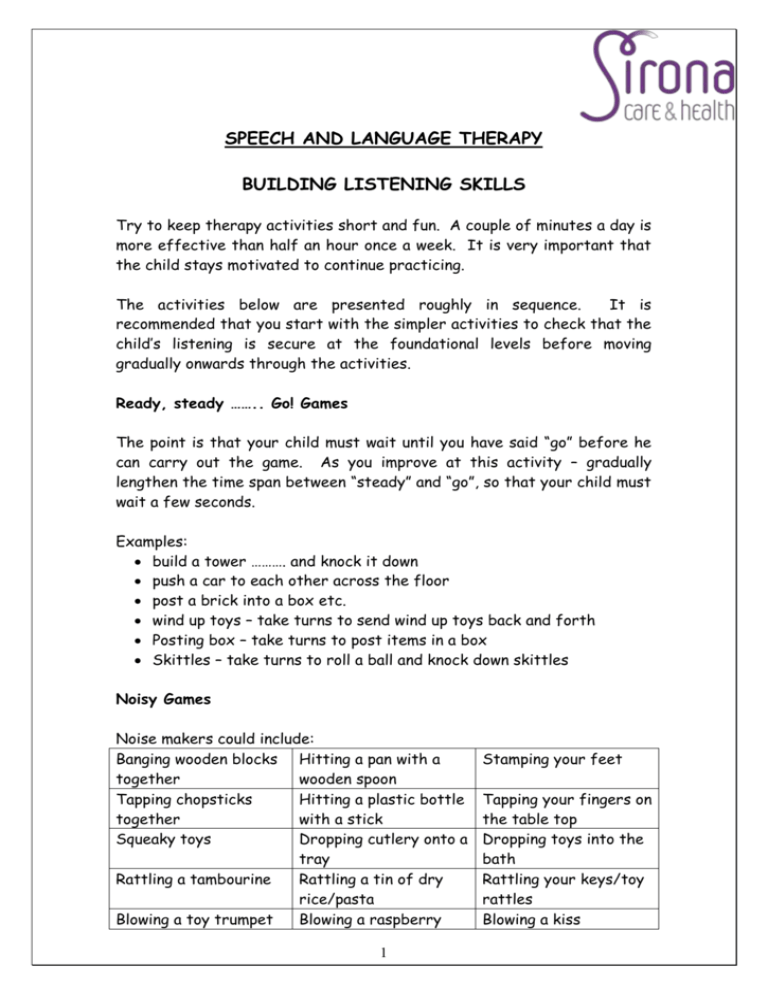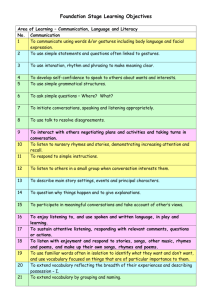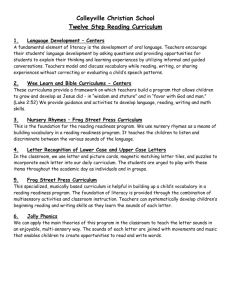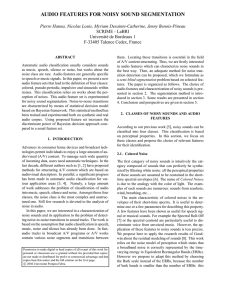Helping you pre-school child to develop listening and
advertisement

SPEECH AND LANGUAGE THERAPY BUILDING LISTENING SKILLS Try to keep therapy activities short and fun. A couple of minutes a day is more effective than half an hour once a week. It is very important that the child stays motivated to continue practicing. The activities below are presented roughly in sequence. It is recommended that you start with the simpler activities to check that the child’s listening is secure at the foundational levels before moving gradually onwards through the activities. Ready, steady …….. Go! Games The point is that your child must wait until you have said “go” before he can carry out the game. As you improve at this activity – gradually lengthen the time span between “steady” and “go”, so that your child must wait a few seconds. Examples: build a tower ………. and knock it down push a car to each other across the floor post a brick into a box etc. wind up toys – take turns to send wind up toys back and forth Posting box – take turns to post items in a box Skittles – take turns to roll a ball and knock down skittles Noisy Games Noise makers could include: Banging wooden blocks Hitting a pan with a together wooden spoon Tapping chopsticks Hitting a plastic bottle together with a stick Squeaky toys Dropping cutlery onto a tray Rattling a tambourine Rattling a tin of dry rice/pasta Blowing a toy trumpet Blowing a raspberry 1 Stamping your feet Tapping your fingers on the table top Dropping toys into the bath Rattling your keys/toy rattles Blowing a kiss Play with these and make the noises. Then your child must cover his eyes and listen while you make a noise, then open his eyes and find the one you used. (you can expand on this by stopping and listening to noises as you go about your daily routine, e.g. the noises you make while washing up! You can vary these activities in the following ways: Blindfold the child. Using a selection of two or three musical instruments make a noise with one of them. Remove the blindfold and ask the child to identify which one made the noise. Extend the above by using similar sounding instruments, e.g. tambourine and bells. As above, the child has to identify a sequence of two or three instruments. There are many variations on this theme, e.g. using two sets of instruments and asking the child to copy the sequence of instruments. Hide a toy/object which make a sound somewhere in the room for the child to find e.g. alarm clock, battery operated toy, musical box, kitchen timer etc. As above, but introduce two sounds for the child to locate. As a group activity – one member of the group makes a sound e.g. saying ‘boo’, whispering, crinkling paper whilst one of the children is blindfolded. The blindfolded child has to decide where the noise came from. These tasks may be graded in difficulty by choice of noisemakers, placing noisemakers at different heights and when the children are good listeners, working against some background noise e.g. radio, TV etc. Animal Noises. This game is one in which the child has to recognise the sounds which an animal makes. Can the child pick out a picture of the animal when you make a noise? Reverse the process so that 2 the child makes the sound and you pick out the animal. (PS Make a mistake sometimes as children love to correct an adult!) Encourage the child to listen to and identify everyday sounds, e.g. hoover, telephone, kettle, traffic, running water etc. Encourage him to imitate and name them. Talk about the sounds you hear around you. Hiding Games a) You hide, e.g. a sweet in a little box, place this in a slightly bigger box and so on up to 3 or 4 boxes, while your child watches. He must then open all the boxes to find it! (You could also use Russian dolls, interlocking cups, etc.). b) You hide, e.g. 3 or 4 toys/objects around the room while your child watches. Talk aloud while you do this, e.g.: “I’m going to hide teddy under the chair and the cup on the table”, etc. Then you sit down together in the middle of the room and you say “Find me the ……”. He must listen and then run and fetch it. Rhymes and Stories Even before a child understands every word of a nursery rhyme he can listen to the rhythm and can pick out the important words and act them out. Sing nursery rhymes and favourite songs and leave a pause for the child to supply the missing word. Tell well-known stories over and over again, pausing for the child to join in at key moments. Stories with repetitive lines such as The Gingerbread Man and The Three Little Pigs are good for this. Make up a story with the child’s name in it. Read it once and repeat it explaining that he must put his hand up when he hears his name. If this is done as a group, use names of the more able children to act as models. Examples of stories and rhymes: Round and round the garden 3 Two little dickie birds Pat-a-cake Incy wincy spider The gingerbread man Three little pigs Head & Shoulders knees & toes Bear Hunt Rhythm and Sequence Games Encourage the child to copy you as you make two beats on a drum or other noise make, keeping the beats evenly spaced and regular. When the child is able to copy you confidently and accurately, move up to three beats and so on, then vary the number of beats each time. To increase the complexity, ask the child to copy the number of beats you make without looking. Use a noisemaker such as a party blower or a whistle to produce long sounds and short sounds. Encourage your child to identify and copy long sounds and short sounds in simple repetitions. Only when the child becomes very accurate in these activities should you move onto creating patterns (for example, ‘beat beat – pause – beat beat’). You should work at the child’s level – not trying to challenge them beyond what they can remember and copy. Finger rhymes and clapping games such as Pat-A-Cake are appropriate at this stage. Also musical chairs/bumps/statues are appropriate at this stage. Listening to Speech Set up a pretend shop, and ask your child to give you specific items. Start by using single words only (apple, ball, teddy), then build short sentences (“Can I have an apple please?”, “Please give me a block”). Vary your sentences so that the item the child is listening for isn’t always the last word you say. As the child gets more confident, ask for two items (“A car and a teddy, please”). This can be extended into everyday routines – either by asking your child to help you unpack the shopping, or by asking him to spot items for you the supermarket. Sing nursery rhymes or action songs, leaving out words for the child to fill in – or deliberately say the wrong word to encourage your child to correct you (for example, “Humpty Dumpty sat on the… bed”). 4 Play Simon Says gradually making the commands longer. To start with, model the action you are asking the child to do – later on, let the child try to work it out first then model the action only if they are struggling. Play word games such as “I went shopping and I bought…” to encourage the child to listen to and remember more items. Other Activities and Games Balloons Blow them up and let them go Feel the air coming out of them Throw and catch them Draw faces on them Peek-a-boo Hide behind a chair or box and suddenly pop up calling “boo”. This can also be done with the child’s toys – make the teddy say “boo” to the child. Inset puzzles/simple jigsaws Talk about each piece as you put them back in the puzzle Hide one piece and ask the child which is missing Hide a piece in one hand and let the child guess which hand Match puzzle pieces to real objects Draw around the pieces Any games like these are very good for helping your child’s attention control to develop. Activities like drawing, painting, playdough, etc., are all good for concentrating! Do not expect your child to concentrate for long – perhaps only a minute at a time or even less at first! Short, frequent sessions are best. For further advice ask your Speech and Language Therapist. 5









